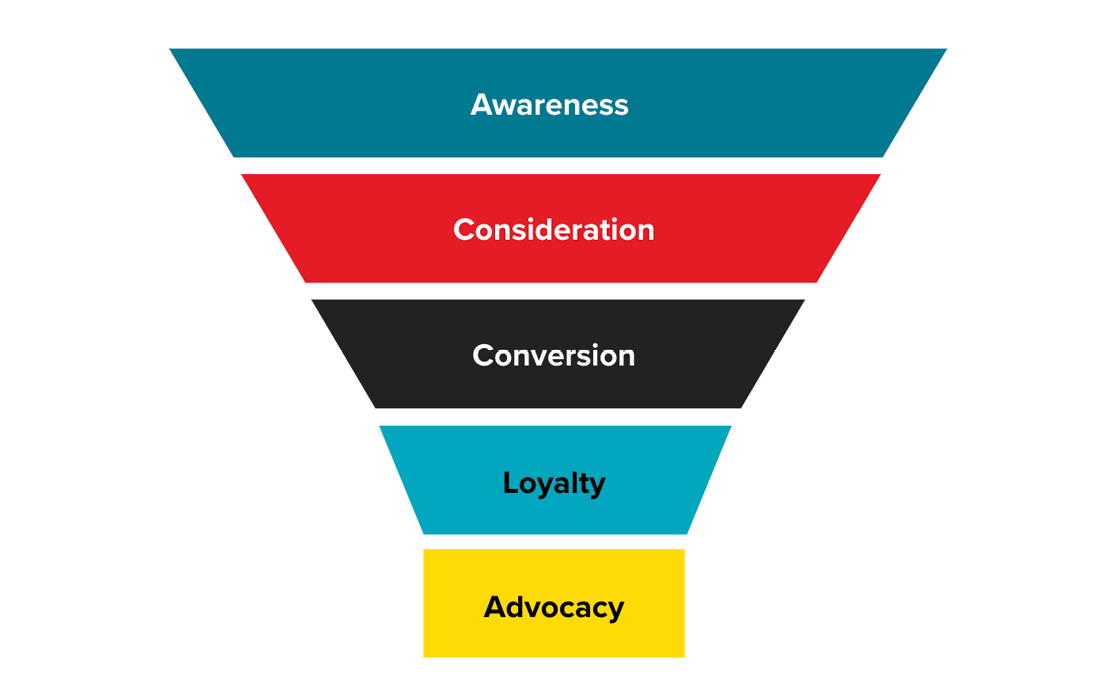Whether you’re a business owner that’s ready to begin marketing your product or service online, or you’re a marketer looking for guidance on how to develop a comprehensive digital marketing strategy, this guide is for you.
Creating a digital marketing plan is critical to success for any and all businesses in today’s digital world. No matter your industry or vertical, your target audience is online in some capacity. If your brand isn’t out there to seize the opportunity, your competitors will be. According to Google, 54% of consumers say they made a purchase from a brand that was new to them in 2020. That new brand could be yours! Developing a strong digital marketing strategy allows your brand to be there at the right time, in the right place, with the right message, for the right target audience.
Before you can develop a comprehensive digital marketing strategy for your brand, there are a few things you need to know to build a strong foundation. Let’s cover the basics.
The 3 Digital Marketing Pillars
There are three different pillars within digital marketing, all of which are important to invest in and tap into when developing a full-funnel digital marketing strategy: paid media, owned media, and earned media.
-
Paid media: Any advertising you can put money behind.
-
For example: paid search, social media, youtube, display ads, affiliate marketing, influencer marketing, print, radio, etc.
-
Owned media: Marketing that your brand has complete ownership and control over.
-
For example: email marketing, your website (think: SEO and content marketing), social media such as your brand’s organic Facebook page or Instagram page, your physical store, events, etc.
-
Earned media: What you earn for being a good brand. It’s the hardest to obtain, but sometimes can be the most powerful.
Within the owned media pillar, one large area of focus for many brands is SEO. SEO stands for Search Engine Optimization. At a high level, SEO allows search engines to understand what your website is about (Check out Moz’s Beginner’s Guide to SEO). This way, when someone searches for something that is relevant to your website, the search engine is able to show your site as one of the many “organic” results. Organic simply means it’s not a paid listing; rather, it’s a listing occurring “organically” from Google or whatever search engine you are using.
Within SEO, there are two big branches: technical SEO and sitewide SEO (this can encompass on-site SEO, off-site SEO, and local SEO). It’s critical to your digital marketing strategy to incorporate SEO optimizations and learnings, alongside considering your site’s user experience and design, as your website is typically at the centre of all digital marketing efforts and it is the cornerstone to online success. As they say, “All roads lead to Rome.” Your website is Rome. 🙂 Prioritize it.
The Digital Marketing Lingo
-
Conversions: The ultimate goal you are trying to achieve (sale, lead, call, appointment)
-
Conversion rate: The percentage of people who visit your site (or click on your ad) and convert
-
CPA/CPL: Cost per action/acquisition or cost per lead (take the total cost of advertising and divide it by the total leads or sales you have acquired)
-
ROAS: Return on Ad Spend (typically a ratio or percentage. For example, if $1 in ad spend results in $4 in revenue, that’s a 400% ROAS; a 4:1 ratio)
-
CPC: Cost per Click (in paid search advertising, you only pay when someone clicks on your ad)
-
Impressions: The number of times your ads are shown or served
-
Bounce rate: Percentage of site visitors who navigate away from the site after viewing only one page (you want this percentage to be below 50%)
-
Target audience: The predetermined qualities and aspects of people who are most likely to want or need your products or services
-
KPI: Key Performance Indicators, used to evaluate the success of a digital marketing campaign based on predetermined objectives
Media Mix Diversification
Think about your own digital behaviour. Do you search for things on Google or Bing? Do you use Facebook, Instagram, Pinterest, TikTok, or all four? Do you scour your email for coupons and deals? Use affiliate sites like RetailMeNot or Rakuten? It’s likely that you didn’t answer yes to just one of these questions, but that you participate in many of these activities across these channels. One of the key aspects of building a successful digital marketing strategy is diversifying your ad spend and marketing efforts to create a well-structured media mix.
“Media mix” refers to the different channels and platforms your brand is investing in. Think of it like you would the stock market. You never want to put all your eggs in one basket. No successful advertiser is only on social media or only does email marketing or only does content marketing. Rather, successful brands develop marketing strategies that span multiple platforms, allowing them to reach their target audience no matter where they are.
Considering "The Funnel"
If you look back at your most recent purchase, it’s likely that you purchased from a brand you were familiar with, rather than one you’ve only heard of once. Brands with successful digital marketing strategies know that there’s value in being patient and taking time with their prospects by “bringing them down the funnel.” As digital marketer Martin JoJarth says, “repetition is effective communication.” In essence, most people tend to explore and consider for a little while before they commit. That’s how successful brands approach their prospects; they consider the three key phases of the marketing funnel: awareness, consideration, and conversion.

-
Awareness: This is the phase in the funnel where brands are getting in front of their target audience for the first time. The ad copy and CTA (call to action) is not going to be too direct or aggressive (e.g. “Learn More” or “View Options”). Brands are working to show prospects that they exist and that they are the solution to problems or needs that consumers have.
-
Consideration: In this phase of the marketing funnel, brands are reminding users of their existence (often called “remarketing” or “retargeting”), and sharing more reasons as to why users should choose their brand over the competition. CTAs may include verbiage that indicates that the brand knows the consumer has already engaged with the brand in some capacity, for example, “come back and shop.”
-
Digital marketing campaigns brands could leverage: non-brand search, email marketing, local, or social media remarketing campaigns
-
Conversion: This is when brands can get very customized in their approach to advertising. This is oftentimes when you see a specific product you’ve recently viewed or you’re being offered a specific coupon based on your most recent digital behaviour. Calls to action will be more direct, and asking for the sale (ex: “Buy Now” or “Try Today”).
-
Digital marketing campaigns brands could leverage: brand search, dynamic remarketing campaigns across social media, display, or youtube
One of the common pitfalls brands encounter is serving the wrong message to the right audience. This can occur when a brand develops ad creative to incorporate into their digital marketing campaigns before they consider the target audience or the phase in the funnel they are working to nurture. This is why when brands develop their marketing strategy, it’s critical to first pin down the target audience, determine what phase of the funnel is being used, then develop ad creative for execution.
Learn From Others
As you wrap up the development of your digital marketing plan, be sure to take advantage of resources within the industry.
-
Take a look at case studies from brands that have succeeded in executing their digital marketing strategy.
-
For social media, take a look at what other brands are doing from an advertising perspective. Use this tool to view other brands’ ads. What ad format are other brands using on social media? How frequently are they posting new ads? What verbiage or CTAs are they leveraging?
-
Continue to learn from industry professionals via General Assembly classes.
Putting Your Digital Marketing Strategy into Action
Every digital marketing strategy will be different for every business. It will take time to learn, improve, and tweak your strategy once it is initially developed. In a world where things can change from one day to the next, it’s important to be versatile and willing to learn. Digital marketing strategies evolve over time as the brand grows and evolves over time.
The key things to remember are:
-
Tap into all 3 digital marketing pillars: paid, owned, and earned media
-
Diversify your media mix. Your prospects are on multiple channels. Don’t develop your strategy around a single marketing channel. Find the balance across multiple tactics.
-
Consider the funnel. Create a content marketing strategy that caters to each of the three primary phases in the marketing funnel. The more people are aware of your brand, the more people search for and consider your brand, the more people buy or choose your brand. Take your time to educate your target audience on how your brand is a solution to a need or problem they have.
-
Learn from others. There are plenty of free classes and resources out there for brands to learn from. As you build out your digital marketing plan, take the time to dig into other brands’ approaches that led to customized, integrated, profitable digital marketing campaigns.
Find out more about General Assembly's Digital Marketing offerings.


General Assembly is a global pioneer in education and career transformation, specialising in today’s most in-demand skills. The leading source for training, staffing, and up-skilling career accelerators, GA fosters a flourishing community of professionals pursuing careers they love. GA offers re-skilling immersive courses for career changers, multi-hour workshops, and free events in tech, design, and business topics.

.png)

